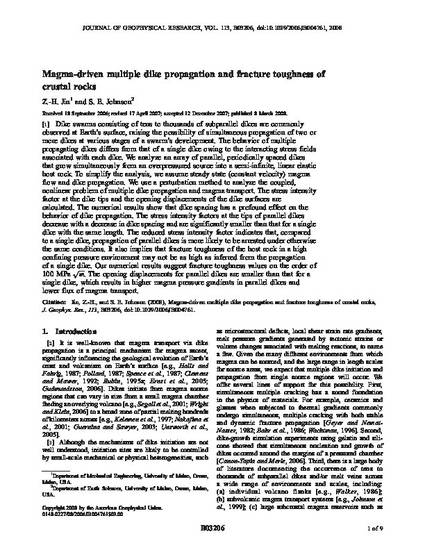
Article
Magma-Driven Multiple Dike Propagation and Fracture Toughness of Crustal Rocks
Journal of Geophysical Research-Solid Earth
Document Type
Article
Rights and Access Note
This Item is protected by copyright and/or related rights. You are free to use this Item in any way that is permitted by the copyright and related rights legislation that applies to your use. In addition, no permission is required from the rights-holder(s) for educational uses. For other uses, you need to obtain permission from the rights-holder(s).
Publication Date
3-8-2008
Publication Number
B03206
Disciplines
Abstract/ Summary
Dike swarms consisting of tens to thousands of subparallel dikes are commonly observed at Earth's surface, raising the possibility of simultaneous propagation of two or more dikes at various stages of a swarm's development. The behavior of multiple propagating dikes differs from that of a single dike owing to the interacting stress fields associated with each dike. We analyze an array of parallel, periodically spaced dikes that grow simultaneously from an overpressured source into a semi-infinite, linear elastic host rock. To simplify the analysis, we assume steady state (constant velocity) magma flow and dike propagation. We use a perturbation method to analyze the coupled, nonlinear problem of multiple dike propagation and magma transport. The stress intensity factor at the dike tips and the opening displacements of the dike surfaces are calculated. The numerical results show that dike spacing has a profound effect on the behavior of dike propagation. The stress intensity factors at the tips of parallel dikes decrease with a decrease in dike spacing and are significantly smaller than that for a single dike with the same length. The reduced stress intensity factor indicates that, compared to a single dike, propagation of parallel dikes is more likely to be arrested under otherwise the same conditions. It also implies that fracture toughness of the host rock in a high confining pressure environment may not be as high as inferred from the propagation of a single dike. Our numerical results suggest fracture toughness values on the order of 100 MPa root m. The opening displacements for parallel dikes are smaller than that for a single dike, which results in higher magma pressure gradients in parallel dikes and lower flux of magma transport.
Citation/Publisher Attribution
Jin, ZH, and Johnson, SE, 2008, Magma-Driven Multiple Dike Propagation and Fracture Toughness of Crustal Rocks: Journal of Geophysical Research-Solid Earth, v. 113, B03206. To view the published open abstract, go to http://dx.doi.org and enter the DOI.
Publisher Statement
© Copyright 2008 American Geophysical Union
DOI
10.1029/2006JB004761
Version
publisher's version of the published document
Citation Information
Z.-H. Jin and Scott E. Johnson. "Magma-Driven Multiple Dike Propagation and Fracture Toughness of Crustal Rocks" Journal of Geophysical Research-Solid Earth Vol. 113 (2008) Available at: http://works.bepress.com/scott_johnson/3/
